Invasions and Local Outbreaks of Four Species of Plague Locusts in South Africa: A Historical Review of Outbreak Dynamics and Patterns
Abstract
:Simple Summary
Abstract
1. Introduction
2. Materials and Methods
3. Results
3.1. The Brown Locust, Locustana Pardalina
3.1.1. Development of Incipient Outbreaks
3.1.2. Brown Locust Control Strategy
3.1.3. Outbreak Frequency
3.1.4. Outbreak Patterns
3.1.5. Threat of the Brown Locust to Agriculture in South Africa
3.2. The African Migratory Locust, Locusta Migratoria Migratorioides
3.2.1. AML Plague Invasion of the 1930s
3.2.2. Incipient Local AML Outbreaks
3.2.3. Outbreaks of AML in Cereal Crop Environments
3.2.4. Population Dynamics of AML in the Cereal Crop Environment on the Highveld of South Africa
3.2.5. Threat of the African Migratory Locust to Agriculture in South Africa
3.3. The Red Locust, Nomadacris Septemfasciata
3.3.1. The First Recorded Plague Invasion
3.3.2. The Second Plague Invasion
3.3.3. The Third Plague Invasion
3.3.4. Small-Scale Red Locust Outbreaks in Southern Africa
3.3.5. Threat of the Red Locust to Agriculture in South Africa
3.4. The Southern African Desert Locust
3.4.1. Distribution and Population Dynamics
3.4.2. Outbreaks of the Southern African Desert Locust
3.4.3. Threat of the Southern African Desert Locust to Agriculture in South Africa
4. Discussion
Funding
Data Availability Statement
Acknowledgments
Conflicts of Interest
References
- Brytania, W. The Locust and Grasshopper Agricultural Manual; Centre for Overseas Pest Research: London, UK, 1982; 690p, ISBN 0-85135-120-4. [Google Scholar]
- Lounsbury, C.P. Some phases of the locust problem. S. Afr. J. Sci. 1915, 11, 33–45. [Google Scholar]
- Anonymous. Policy for Managing the Locust Problem in South Africa. National Department of Agriculture. September 1998. Available online: https://www.nda.agric.za/docs/policy/policy98.htm (accessed on 9 August 2021).
- Price, R. Alternative strategies for controlling the brown locust, Locustana pardalina (Walker). Agronomy 2021, 11, 2212. [Google Scholar] [CrossRef]
- Du Plessis, C.; Botha, D.H. Preliminary field experiments on the attractiveness of certain chemicals and bait carriers to hoppers of the brown locust. J. Entomol. Soc. S. Afr. 1939, 2, 74–92. [Google Scholar]
- Du Plessis, C. The influence of weather conditions on the incipient swarming of the brown locust, Locustana pardalina (Walker). Sci. Bull. Dep. Agric. For. Union S. Afr. 1938, 186, 1–51. [Google Scholar]
- Lea, A. Recent outbreaks of the brown locust with special reference to the influence of rainfall. J. Entomol. Soc. S. Afr. 1958, 21, 162–213. [Google Scholar]
- Faure, J.C. The life history of the brown locust, Transvaal University College, Pretoria. J. Dep. Agric. Union S. Afr. 1923, 4, 205–224. [Google Scholar]
- Potgieter, J.T. A contribution to the biology of the brown swarm locust and its natural enemies. Sci. Bull. Dep. Agric. Union S. Afr. 1929, 82, 1–48. [Google Scholar]
- Smit, C.J.B. Field observations on the brown locust in an outbreak centre. Sci. Bull. Dep. Agric. For. Union S. Afr. 1939, 190, 1–143. [Google Scholar]
- Smit, C.J.B. The behaviour of the brown locust in its solitary phase. Tech. Commun. Dep. Agric. Tech. Serv. Pretoria. 1960, 1, 132. [Google Scholar]
- Lea, A. Natural regulation and artificial control of brown locust numbers. J. Entomol. Soc. S. Afr. 1968, 31, 89–112. [Google Scholar]
- Lea, A. The distribution and abundance of brown locusts between 1954 and 1965. J. Entomol. Soc. S. Afr. 1969, 32, 367–398. [Google Scholar]
- Matthee, J.J. The structure and physiology of the egg of Locustana pardalina (Walker). Sci. Bull. Dep. Agric. For. Union S. Afr. 1951, 316, 1–83. [Google Scholar]
- Botha, D.H. The viability of brown locust eggs, Locustana pardalina (Walker). S. Afr. J. Agric. Sci. 1967, 10, 445–460. [Google Scholar]
- Du Plessis, C. The incipient outbreaks of the brown locust in 1937–1938 with special reference 673 to biometrical analysis. Sci. Bull. Dep. Agric. For. Union S. Afr. 1939, 209, 1–69. [Google Scholar]
- Lea, A. Some major factors in the population dynamics of the brown locust, Locustana pardalina (Walker). Monogr. Biol. 1964, 14, 269–283. [Google Scholar]
- Lea, A. The plague dynamics of the brown locust, Locustana pardalina (Walk.). In Proceedings of the International Study Conference on the Current and Future Problems of Acridology, London, UK, 6–16 July 1970; Hemming, C.F., Taylor, T.H.C., Eds.; pp. 289–297. [Google Scholar]
- Faure, J.C. The phases of locusts in South Africa. Bull. Entomol. Res. 1932, 23, 293–405. [Google Scholar] [CrossRef]
- Ibebuchi, C.C. Revisiting the 1992 severe drought episode in South Africa: The role of El Niño in the anomalies of atmospheric circulation types in Africa south of the equator. Theor. Appl. Climatol. 2021, 146, 723–740. [Google Scholar] [CrossRef]
- Faure, J.C.; Marais, S.J.S. The control of Locustana pardalina in its outbreak centres. In Proceedings of the 4th International Locust Conference, Cairo, Egypt, 22 April 1936; 1937, Appendix 37. p. 5. [Google Scholar]
- Kieser, M.E.; Thackrah, A.; Rosenberg, J. Changes in the outbreak region of the brown locust in Southern Africa. Grootfontein Agric. 2002, 4, 20–23. Available online: http://gadi.agric.za/articles/Kieser_M/kieser_vol4_2002_locust.php (accessed on 9 August 2021).
- Verdier, M. The different life cycles in Locusta in relation to climatic and genetic diversity. In Proceedings of the International Study Conference Current and Future Problems of Acridology, London, UK, 6–16 July 1970; Hemming, C.F., Taylor, T.H.C., Eds.; pp. 335–338. [Google Scholar]
- Farrow, R.A. The African migratory locust in its main outbreak area of the Middle Niger: Quantitative studies of solitary populations in relation to environmental factors. Locusta 1975, 11, 198. [Google Scholar]
- Lean, O.B. Locusta migratoria migratorioides, R. & F.: An ecological reconnaissance of the suspected Middle Niger outbreak area. Bull. Entomol. Res. 1936, 27, 105–190. [Google Scholar]
- Batten, A. The course of the last major plague of the African migratory locust, 1928 to 1941. FAO Pl. Prot. Bull. 1966, 14, 1–16. [Google Scholar]
- Botha, D.H. Locusts and their control in South Africa (Part III). The African migratory locust. Fmg S. Afr. 1969, 45, 39–40. [Google Scholar]
- Lea, A. Locust Control and Research in Southern Africa, Entomology Memoir; Department of Agricultural Technical Services of South Africa Government Printer: Pretoria, South Africa, 1973; ISBN 0-621-00338-7.
- Brown, H.D. New locust problem. Antenna 1986, 10, 11–13. [Google Scholar]
- Farrow, R.A. Comparative plague dynamics of tropical Locusta (Orthoptera, Acrididae). Bull. Entomol. Res. 1974, 64, 401–411. [Google Scholar] [CrossRef]
- Price, R.E.; Brown, H.D. Reproductive performance of the African migratory locust, Locusta migratoria migratorioides (Orthoptera: Acrididae), in a cereal crop environment in South Africa. Bull. Entomol. Res. 1990, 80, 465–472. [Google Scholar] [CrossRef]
- Stewart, D.A.B. Economic losses in cereal crops flowing damage by the African migratory locust, Locusta migratoria migratorioides (Reiche & Fairmaire) (Orthoptera: Acrididae), in the Northern Province of South Africa. Afr. Entomol. 1997, 5, 167–170. [Google Scholar]
- Gunn, D.L. Nomad encompassed. The development of preventative control of the red locust, Nomadacris septemfasciata (Serville) by the International Red Locust Control Service. J. Entomol. Soc. S. Afr. 1960, 23, 65–125. [Google Scholar]
- Byaruhanga, E.K. Developments in the strategy of red locust plague prevention in the fifty year history of the International Red Locust Control Organisation for Central and Southern Africa. Insect Sci. Appl. 1999, 19, 259–264. [Google Scholar] [CrossRef]
- Bahana, J.W.; Byaruhanga, E.K. Advances and review of strategies for red locust plague prevention: The control of the red locust, Nomadacris septemfasciata (Serville) into the 21st century. Insect Sci. Appl. 1999, 19, 265–272. [Google Scholar] [CrossRef]
- Lea, A.; Webb, D.V.V. Field observations on the red locust at Lake Rukwa in 1936 and 1937. Sci. Bull. Dep. Agric. For. Union S. Afr. 1939, 189, 1–81. [Google Scholar]
- Vesey-Fitzgerald, D.F. The vegetation of the outbreak area of the red locust Nomadacris septemfasciata Serv. in Tanganyika and Northern Rhodesia. Anti-Locust Bull. 1955, 20, 1–31. [Google Scholar]
- Symmons, P.M. The effect of climate and weather on the numbers of the red locust, Nomadacris septemfacsciata (Serville), in the Rukwa Valley outbreak area. Bull. Entomol. Res. 1959, 50, 507–521. [Google Scholar] [CrossRef]
- Symmons, P.M.; Carnegie, A.J.M. Some factors affecting breeding and ovioposition of the red locust, Nomadacris septemfasciata (Serv.). Bull. Entomol. Res. 1959, 50, 333–335. [Google Scholar] [CrossRef]
- Dean, G.J.W. Observations on the structure of hopper bands and movements of hoppers of the red locust, Nomadacris septemfasciata (Serville). J. Entomol. Soc. S. Afr. 1967, 30, 1–17. [Google Scholar]
- Morant, V. Migrations and breeding of the red locust, (Nomadacris septemfacsciata Serville) in Africa, 1927–1945. Anti-Locust Mem. 1947, 2, 1–59. [Google Scholar]
- Botha, D.H. Locusts and their control in South Africa (II). The red locust. Fmg S. Afr. 1969, 45, 52–53+55. [Google Scholar]
- Du Plessis, C. The occurrence of the brown and red locust in the Union during the seasons 1934-35 and 1935-36. Sci. Bull. Dep. Agric. For. Union S. Afr. 1937, 164, 1–17. [Google Scholar]
- Du Plessis, C. Locust outbreaks in the Union during the season 1936-37. Sci. Bull. Dep. Agric. For. Union S. Afr. 1938, 181, 1–12. [Google Scholar]
- Brown, H.D. The return of the red locust. S. Afr. Sugar J. 1982, 66, 426–433. [Google Scholar]
- Bahana, J.W.; Ngazero, A.K. A locust plague in the making: Upsurges of the red locust, Nomadacris septemfasciata (Serville) in the Buzi-Gorongosa outbreak area, Mozambique in 1996. Insect Sci. Appl. 1999, 19, 291–300. [Google Scholar] [CrossRef]
- Uvarov, B. Grasshoppers and Locusts. A Handbook of General Acridology; Centre for Overseas Pest Research: London, UK, 1977; Volume 2, 613p, ISBN 0-85135-072-0. [Google Scholar]
- Botha, D.H. Some phase characteristics of the southern African form of the desert locust, Schistocera gregaria (Forskal). S. Afr. J. Agric. Sci. 1967, 10, 61–76. [Google Scholar]
- Waloff, Z.; Pedgley, D.E. Comparative biogeography and biology of the South American locust, Schistocerca cancellata (Serville), and the South African desert locust, S. gregaria flaviventris (Burmeister) (Orthoptera: Acrididae): A review. Bull. Entomol. Res. 1986, 76, 1–20. [Google Scholar] [CrossRef]
- Chapuis, M.P.; Foucart, A.; Plantamp, C.; Blodin, L.; Leménager, N.; Benoit, L.; Gay, P.-E.; Bazelet, C.S. Genetic and morphological variation in non-polyphenic southern African populations of the desert locust. Afr. Entomol. 2017, 25, 13–23. [Google Scholar] [CrossRef]
- Al-khalaf, A.A.; Ghareeb, A.; Alshammery, K.A.; Ibramim, H.A.M. Univariate and multivariate morphometric analysis of the northern and southern populations of the desert locust, Schistocerca gregaria (Orthoptera: Acrididae). Afr. Entomol. 2021, 1, 248–261. [Google Scholar] [CrossRef]
- Faure, J.C. The life history of the red locust (Nomadacris septemfasciata (Serville)). Bull. Dep. Agric. For. Union S. Afr. 1935, 144, 1–32. [Google Scholar]
- Botha, D.H. Locusts and their control in S.A. (Part 4). The southern African desert locust. Fmg S. Afr. 1969, 45, 110–111+116. [Google Scholar]
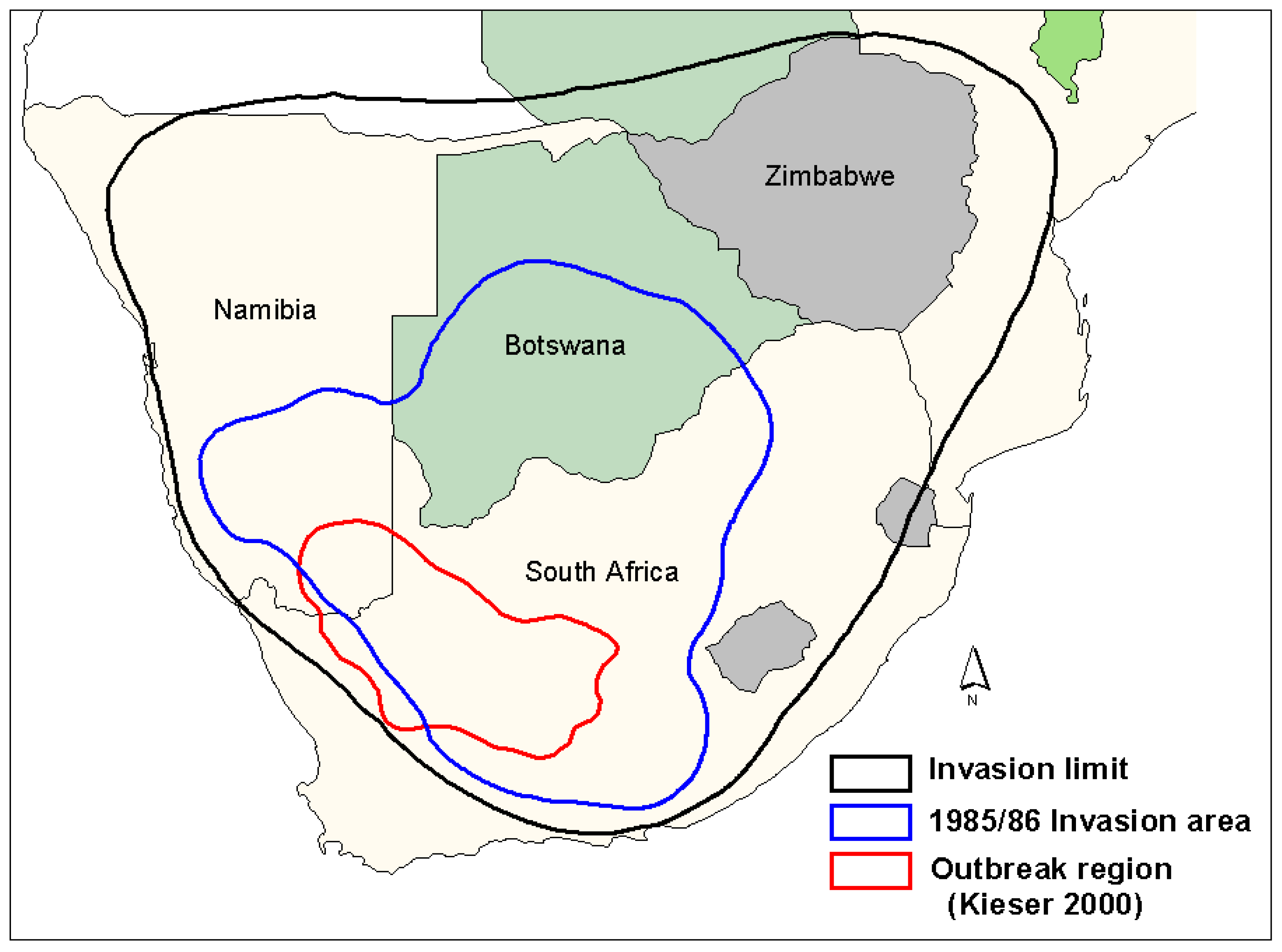
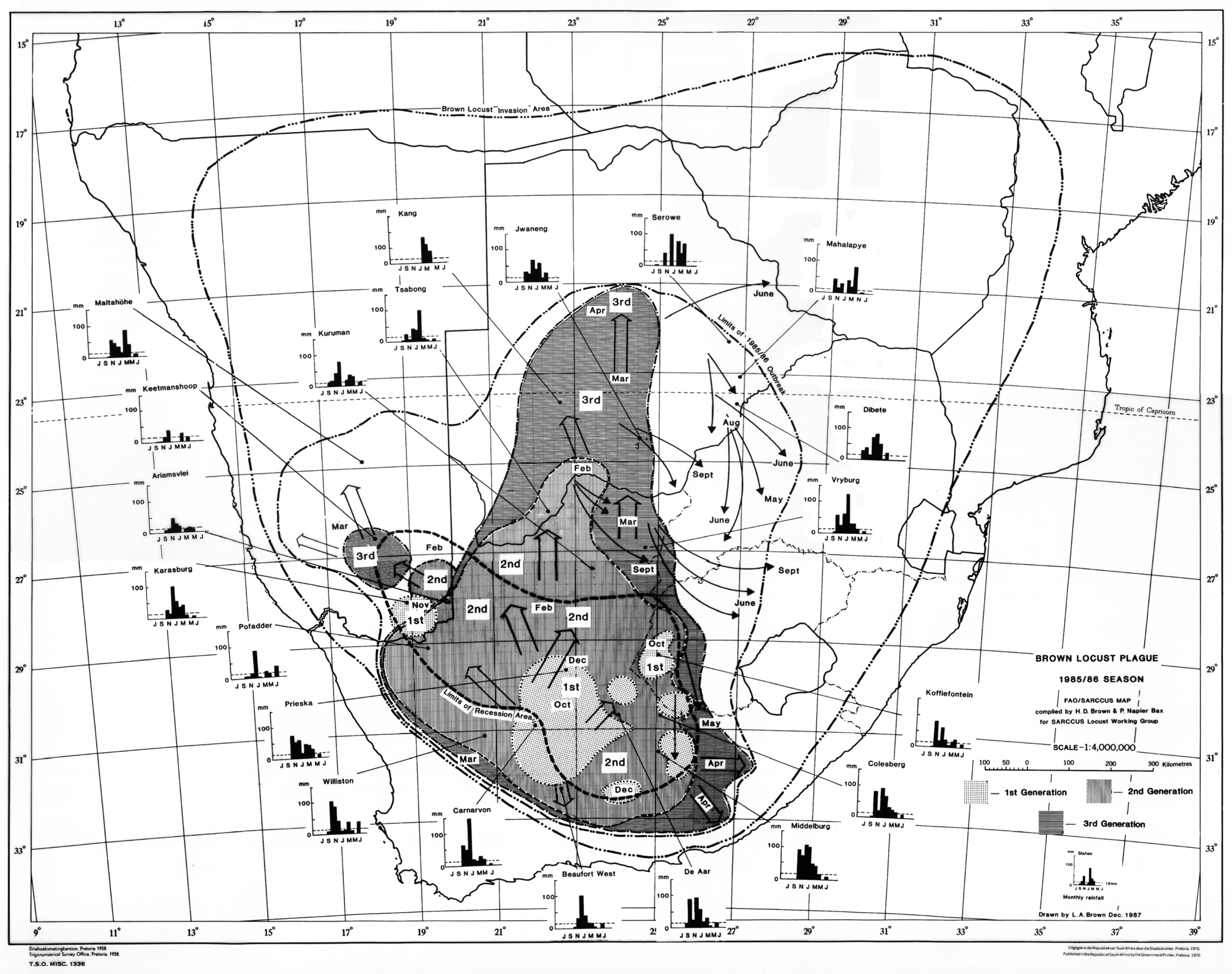
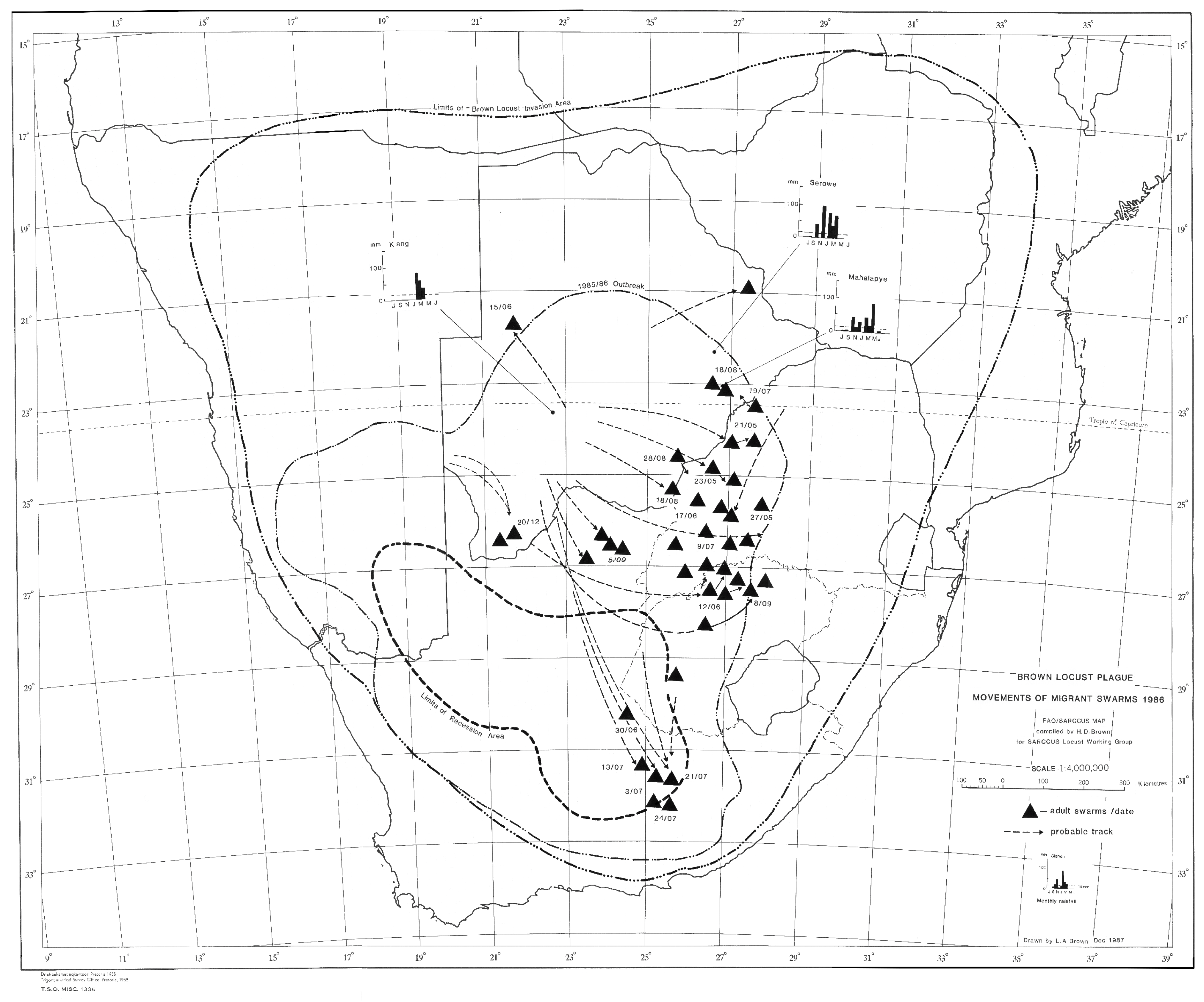
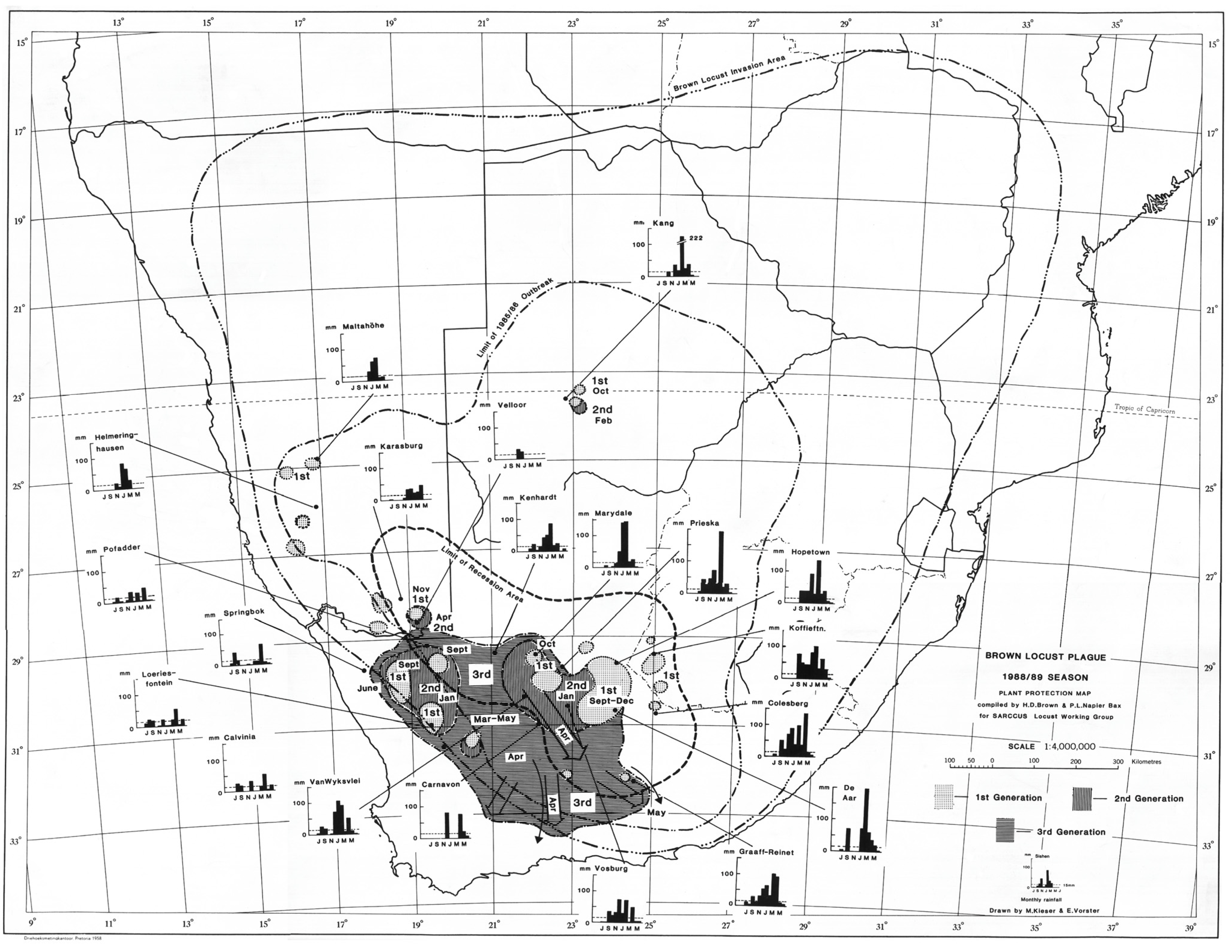
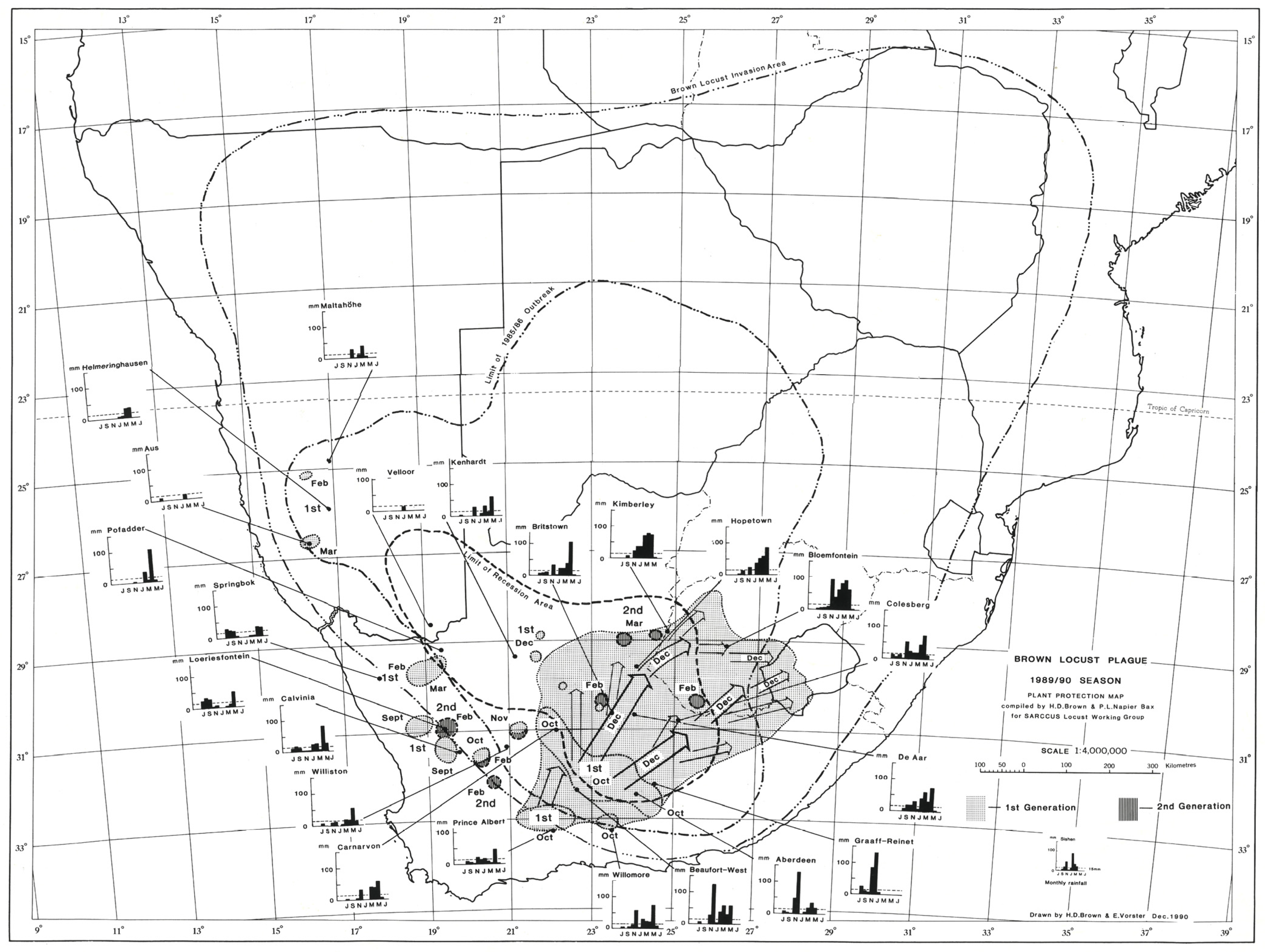
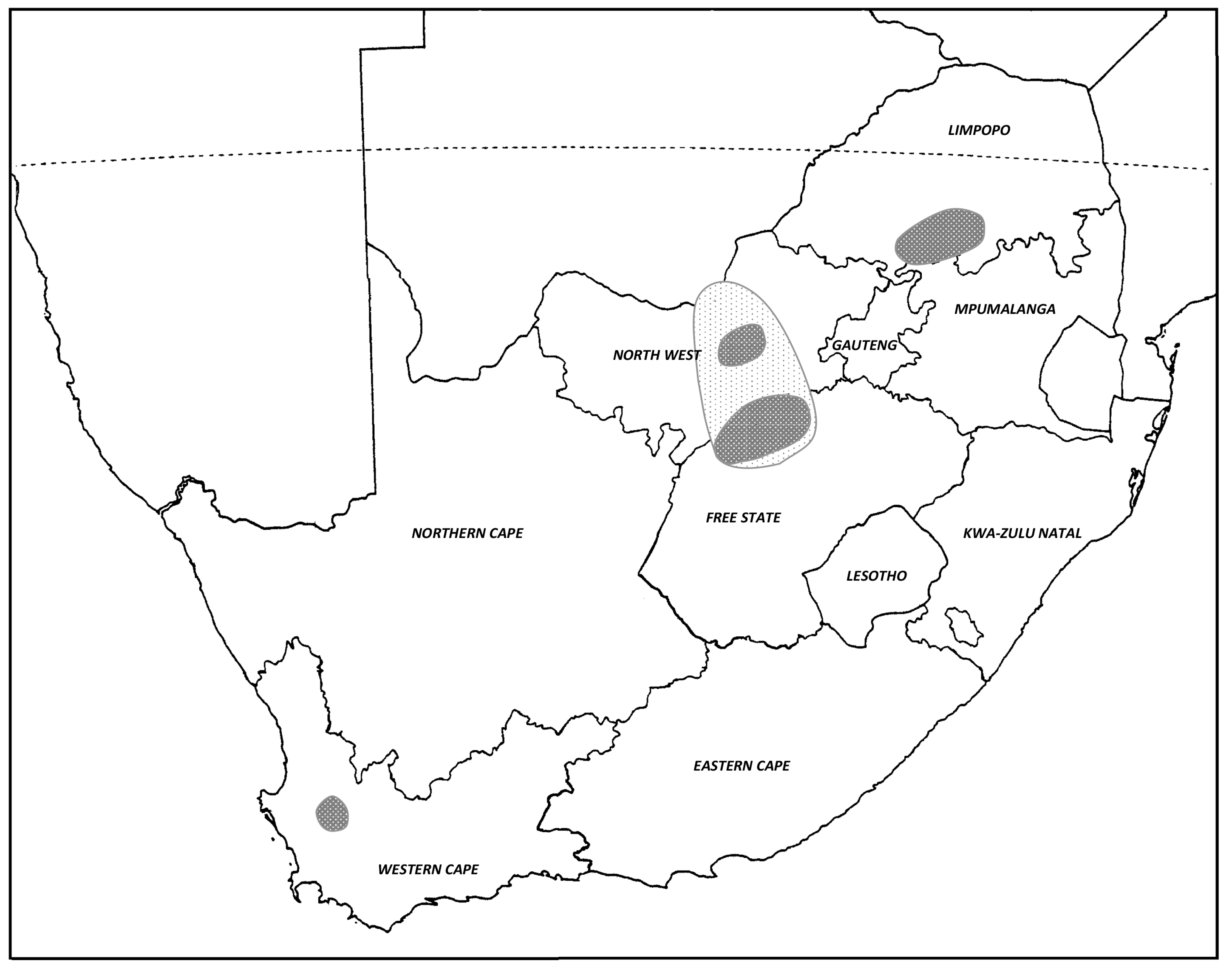
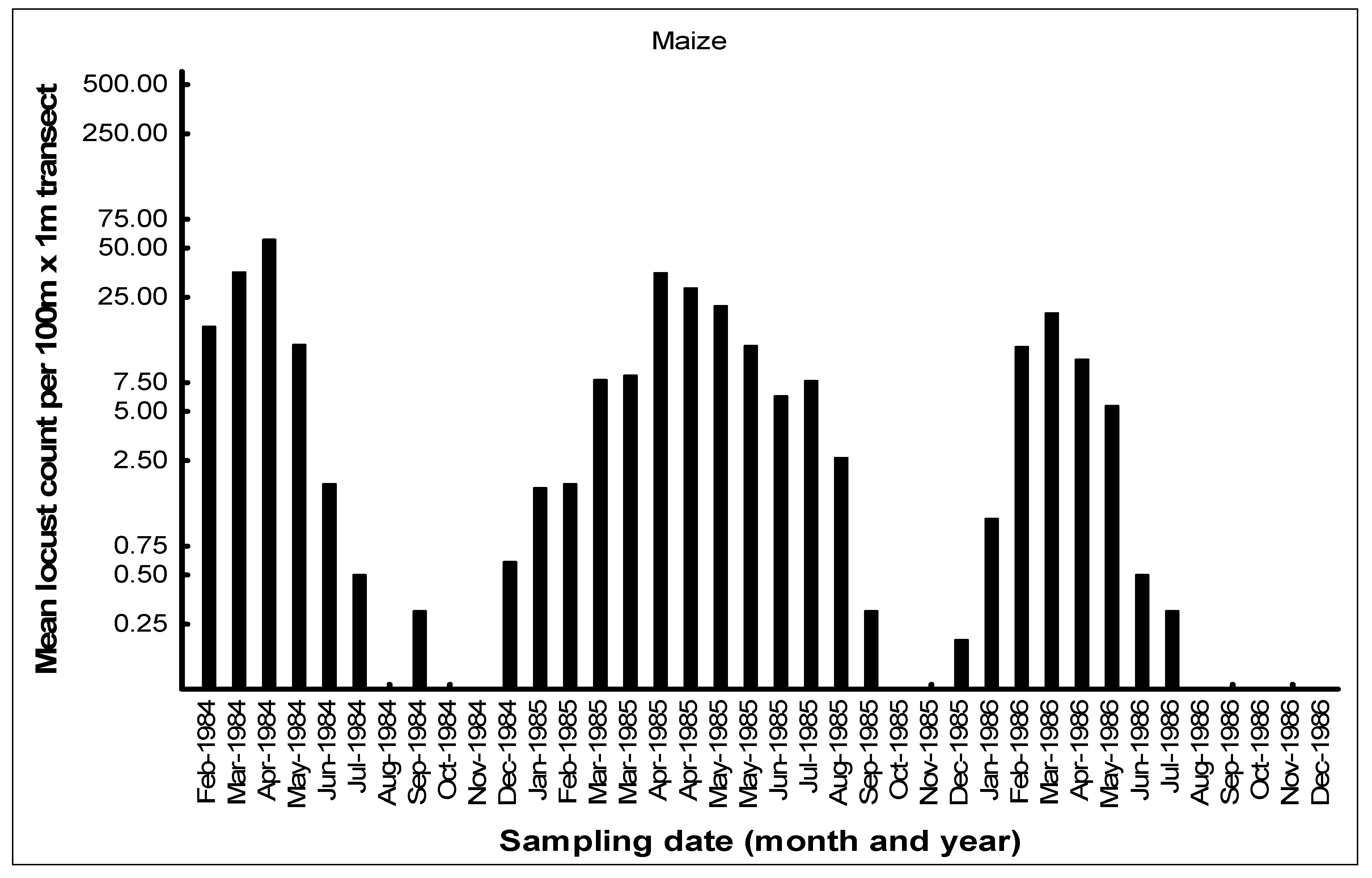
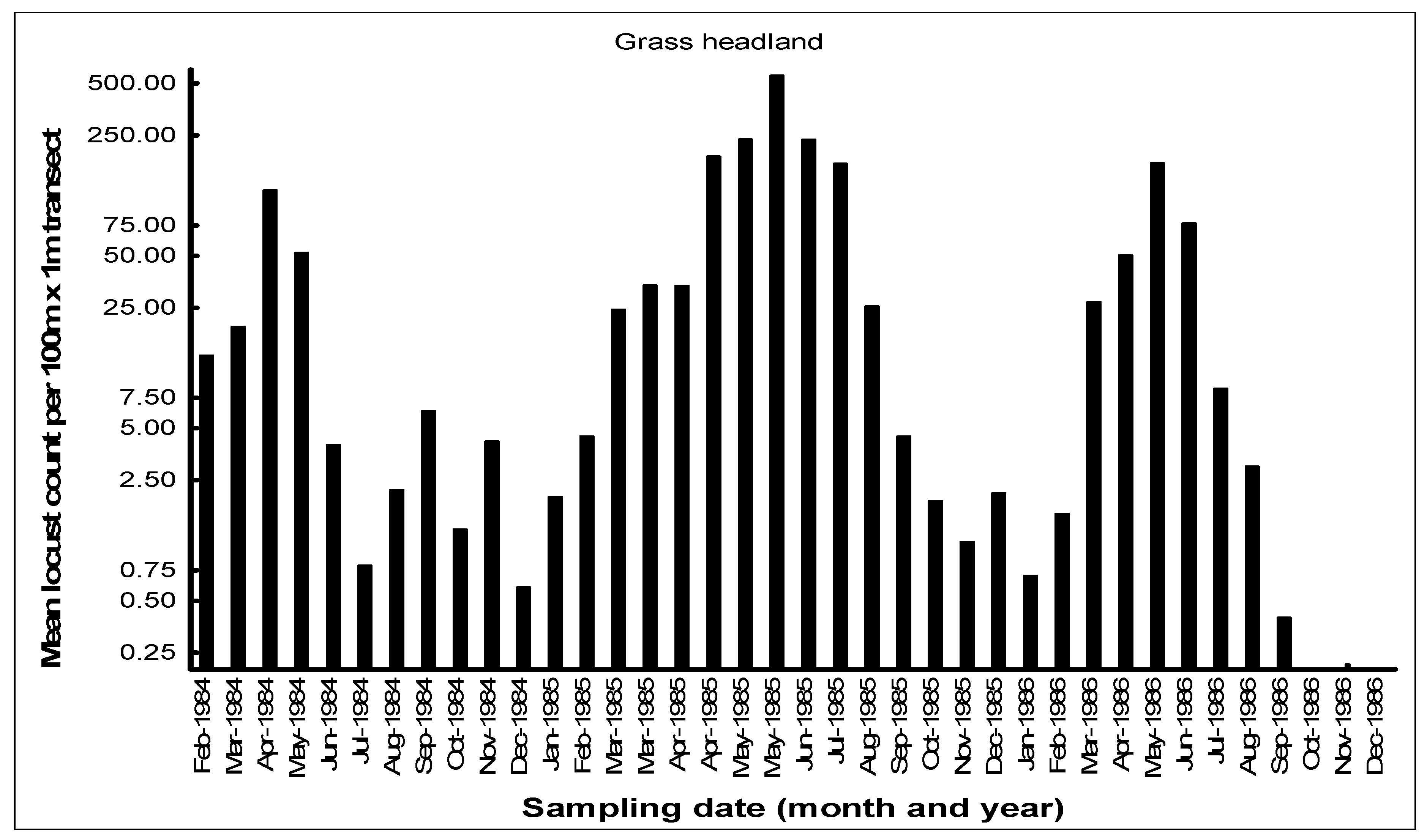
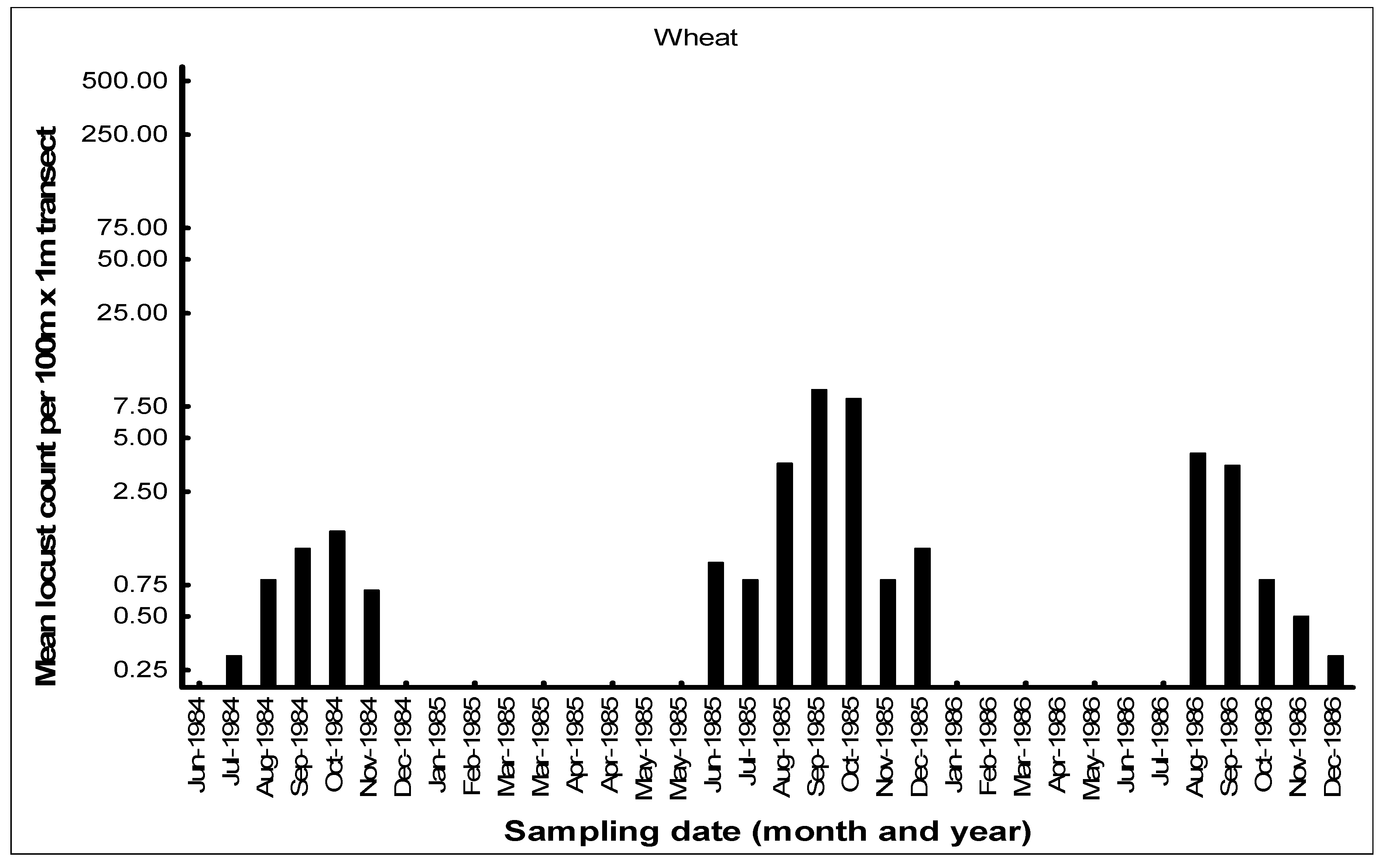
Disclaimer/Publisher’s Note: The statements, opinions and data contained in all publications are solely those of the individual author(s) and contributor(s) and not of MDPI and/or the editor(s). MDPI and/or the editor(s) disclaim responsibility for any injury to people or property resulting from any ideas, methods, instructions or products referred to in the content. |
© 2023 by the author. Licensee MDPI, Basel, Switzerland. This article is an open access article distributed under the terms and conditions of the Creative Commons Attribution (CC BY) license (https://creativecommons.org/licenses/by/4.0/).
Share and Cite
Price, R.E. Invasions and Local Outbreaks of Four Species of Plague Locusts in South Africa: A Historical Review of Outbreak Dynamics and Patterns. Insects 2023, 14, 846. https://doi.org/10.3390/insects14110846
Price RE. Invasions and Local Outbreaks of Four Species of Plague Locusts in South Africa: A Historical Review of Outbreak Dynamics and Patterns. Insects. 2023; 14(11):846. https://doi.org/10.3390/insects14110846
Chicago/Turabian StylePrice, Roger Edward. 2023. "Invasions and Local Outbreaks of Four Species of Plague Locusts in South Africa: A Historical Review of Outbreak Dynamics and Patterns" Insects 14, no. 11: 846. https://doi.org/10.3390/insects14110846
APA StylePrice, R. E. (2023). Invasions and Local Outbreaks of Four Species of Plague Locusts in South Africa: A Historical Review of Outbreak Dynamics and Patterns. Insects, 14(11), 846. https://doi.org/10.3390/insects14110846





